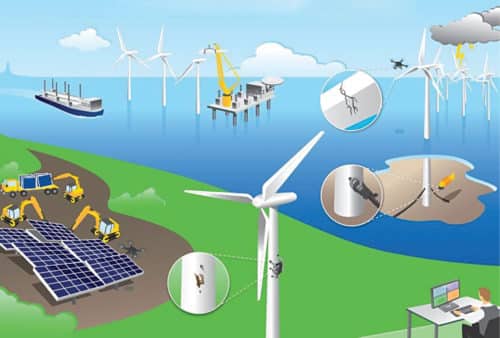The introduction of artificial intelligence (AI) has helped utilities as well as other energy companies in forecasting renewable energy production and electricity demand. AI also helps in actively delivering infrastructure maintenance and predicting equipment failure. Thus with AI, there has been better integration of large-scale renewable energy systems.
The global energy market is undergoing a huge transformation in the process of making energy clean and reliable for dealing with current world problems like climate change. This is making it difficult for energy companies to manage everything via traditional methods.
Utilities as well as other energy companies are finding ways to bridge the demand and supply gap that has arisen due to the increased use of renewable energy sources.
Harnessing technologies like artificial intelligence (AI) offers new solutions to manage the changes and be ready for the next generation of the grid.

As renewable sources like solar and wind are variable in nature, the power supply may not be in sync with consumer needs. There are times when conventional sources still need to be activated as a backup. Users also act as providers when the energy generated is more than their needs, and they send the remainder back to the grid.
There is a massive amount of data available from multiple sources within the utility market. When smart meters were growing, and traditional meters were being replaced in the US, Oracle had reported that this would generate one billion customer data points each day, that is, three thousand times more information than that from the old meters. This number has grown to a much greater extent now. Smart grids, with embedded sensors for sending information to software and monitoring systems, can thus use AI to digitalise energy.
AI can be deployed to forecast renewable energy production as well as weather and short-term, medium-term, or long-term electricity demand. AI algorithms, like those developed by Google’s company DeepMind, can handle zettabytes of structured and unstructured data collected from wind or solar panels to identify patterns and make predictions and recommendations based on them. AI can help in actively delivering infrastructure maintenance and predicting equipment failure. AI-driven optimisation is vital to maximise efficiency with real-time monitoring. Predicting what kind of production a solar or wind farm in a specific location might achieve can attract investments.
Fraud or even energy theft is more common than one might think. AI can combat energy piracy by enabling utilities providers to scan individual consumer details, their usage patterns, payment history, and alerting about suspicious discrepancies between billing and usage data.
In conjunction with this, the technology empowers the consumers through two-way communication with the utility companies. Customer experience is a top business priority for any business. Repetitive type of customer-side tasks like payments, basic inquiries related to billing, complaints, changes in customer details, and the like can be simply solved through virtual agents and chatbots, saving time and money.
In rural areas especially, invoices and other records are still in hand-written form. With capabilities like natural language processing, AI can help in digitising these records. We can even go as far as instructing users on how to install or activate products related to energy management via AI and computer vision if they want to set them up in their homes.
The result is better integration of large-scale renewable energy systems, thereby lowering peak demand, efficient power transmission, reduced operations, and management costs, which are essential to meet economic and environmental needs.
In 2018, SLAC National Accelerator Laboratory at Stanford University came up with a software platform called VADER, which stands for Visualization and Analytics of Distribution Systems with Deep Penetration of Distributed Energy Resources. It can model potential changes in connectivity and behaviour of various resources on the grid using AI for resource optimisation. In India, numerous startups like Avrioenergy, The Solar Labs, and many more are working in this sector.
While the training speed of algorithms has improved due to better computational power, AI presents threats like cyberattacks on an automated power grid. Applying AI in the right way is crucial to successfully deploy it on a large scale. Inadequate quality of training data can lead to false predictions. This causes a lot of time and effort to be spent on data categorisation and integration rather than the task at hand.
But given the potential benefits, as technologies become more advanced, there will be enormous adoption of AI worldwide in the energy sector.







good